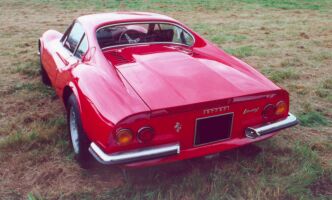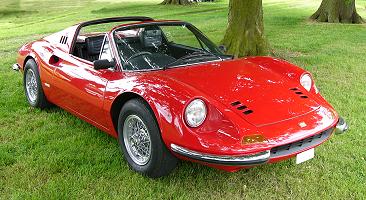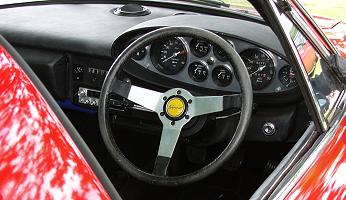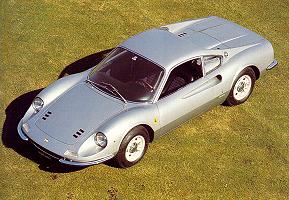This page covers the following models :
Dino 206
Dino 246
The Dino 308 GT4 is featured on the 308 page.
The Dino 208 GT4 is featured on the 208 page.
Dino 206
The first road car with a Dino badge was
seen on the Pininfarina stand at the Paris Motorshow in 1965 (the Dino
206 GT Speciale), based on a race car. The priciple feature was the V6
engine, a configuration never used by Ferrari until then. A combination
of Enzo Ferrari's unwillingness to have a V6 Ferrari, and his desire to
build a tribute his late son ('Alfredino', hence Dino) led to the V6 cars
being sold as Dino's, at least until the mid-1970's.
The 206GT appeared in production trim in
1967 and had a transversely mounted 1987cc V6 producing 180bhp. Due to
its small size, low weight and excellent balance, this was enough to make
the 206GT an excellent 'drivers car'.
Despite not being badged a Ferrari, the
design was by Pininfarina, construction of the bodies was by Scaglietti
and final assembly was done at Maranello. The exceptional design was universally
acclaimed and used an alloy body over the steel frame. The engines, although
designed by Ferrari, were actually built by Fiat (although it should be
noted that the Ferrari version was more powerful than that fitted to the
Fiat Dino).
Technical Details
| Engine |
1987cc (86x57mm) 65deg V6 dohc (per bank) with 180bhp @ 8,000rpm |
| Suspension |
front : independent using double wishbones with coil springs
rear : independent using double wishbones with coil springs
wheelbase : 2280mm
track (front/rear) : 1425mm/1400mm |
| Brakes |
discs all round with servo assistance |
| Transmission |
5 speed manual |
| Kerb weight |
900kg |
Dino 246
 After
only 152 of the 2-litre engined cars had been built, in 1969 the 246GT
appeared on the scene. The engine was a larger 2419cc unit, now with a
cast-iron block and producing 195bhp. This increased power, however, was
hardly enough to offset the increased weight, resulting from both the cast-iron
block, a stretched wheelbase and a steel body. Various other modifications
were made including a larger fuel tank, five stud wheel fittings (the 206
had centre-lock wheels with spinners) and electric windows on some examples.
After
only 152 of the 2-litre engined cars had been built, in 1969 the 246GT
appeared on the scene. The engine was a larger 2419cc unit, now with a
cast-iron block and producing 195bhp. This increased power, however, was
hardly enough to offset the increased weight, resulting from both the cast-iron
block, a stretched wheelbase and a steel body. Various other modifications
were made including a larger fuel tank, five stud wheel fittings (the 206
had centre-lock wheels with spinners) and electric windows on some examples.
In 1972, at the Geneva Motorshow, the 246GT
was joined by the 246GTS which featured a removable targa roof panel. The
small rear side windows were also deleted, the butresses becoming solid
with three-slat vents. Production of both models went on until 1973 by
which time 2,732 GT's and 1,180 GTS's had been built. It is worth stressing
that (despite many owners' modifications) these cars were never sold with
any Ferrari badges on them. This engine was also used very successfully
in the Lancia Stratos.

Technical Details
as for Dino 206 except :
| Engine |
2419cc (92.5x60mm) V6 dohc (per bank) with 195bhp @ 7,600rpm |
| Suspension |
whelbase : 2340mm
track (front/rear) : 1425mm/1430mm |
| Brakes |
ventilated discs |
| Kerb weight |
1,080kg |
 See our picture gallery index for images from museums, motorshows and events.
See our picture gallery index for images from museums, motorshows and events.
There are also wallpapers/desktop backgrounds available to download.

Use the buttons at the top to navigate
further, or
Back to the top
Copyright © 2000 to 2011 CarsfromItaly
 This page covers the following models :
This page covers the following models :
 After
only 152 of the 2-litre engined cars had been built, in 1969 the 246GT
appeared on the scene. The engine was a larger 2419cc unit, now with a
cast-iron block and producing 195bhp. This increased power, however, was
hardly enough to offset the increased weight, resulting from both the cast-iron
block, a stretched wheelbase and a steel body. Various other modifications
were made including a larger fuel tank, five stud wheel fittings (the 206
had centre-lock wheels with spinners) and electric windows on some examples.
After
only 152 of the 2-litre engined cars had been built, in 1969 the 246GT
appeared on the scene. The engine was a larger 2419cc unit, now with a
cast-iron block and producing 195bhp. This increased power, however, was
hardly enough to offset the increased weight, resulting from both the cast-iron
block, a stretched wheelbase and a steel body. Various other modifications
were made including a larger fuel tank, five stud wheel fittings (the 206
had centre-lock wheels with spinners) and electric windows on some examples.

![]() See our picture gallery index for images from museums, motorshows and events.
See our picture gallery index for images from museums, motorshows and events.
